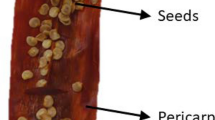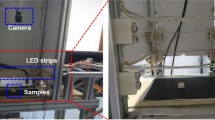Abstract
Spectroscopy coupled with deep learning is widely studied for powdered food materials authentication, such as quality ranking and powder identification. However, the models need retraining when new categories are expected to be covered. We proposed a portable device for powder identification using metric learning. Six powders were used to train a deep learning feature extractor and establish a reference library. Then, a few samples of another six new categories were processed for reference library extension. Without retraining, the device discriminated samples of 12 categories using the cosine similarity values between the test samples and the reference records in the library, which achieved an accuracy of 97.86%, outperforming the K-nearest-neighbor and partial least squares method. The proposed method also showed stronger adaptability to the variation of the number of reference samples. The device could cover more powders by adding very few samples of each new category, showing its strong advantages in practical applications.





Similar content being viewed by others
Data Availability
The data used in this study are available from the corresponding author upon reasonable request.
References
Arendse, E., Nieuwoudt, H., Magwaza, L. S., Nturambirwe, J. F. I., Fawole, O. A., & Opara, U. L. (2021). Recent advancements on vibrational spectroscopic techniques for the detection of authenticity and adulteration in horticultural products with a specific focus on oils, juices and powders. Food and Bioprocess Technology, 14(1), 1–22. https://doi.org/10.1007/s11947-020-02505-x
Bec, K. B., Grabska, J., & Huck, C. W. (2021). Current and future research directions in computer-aided near-infrared spectroscopy: A perspective. Spectrochimica Acta Part a-Molecular and Biomolecular Spectroscopy, 254, Article 119625. https://doi.org/10.1016/j.saa.2021.119625
Chen, C., Yang, B., Si, R. M., Chen, C., Chen, F. F., Gao, R., ... & Lv, X. Y. (2021a). Fast detection of cumin and fennel using NIR spectroscopy combined with deep learning algorithms. Optik, 242, Article 167080. https://doi.org/10.1016/j.ijleo.2021a.167080
Chen, J. W., Guo, Z. W., & Hu, J. L. (2021b). Ring-regularized cosine similarity learning for fine-grained face verification. Pattern Recognition Letters, 148, 68–74. https://doi.org/10.1016/j.patrec.2021.04.029
da Costa, A. Z., Figueroa, H. E. H., & Fracarolli, J. A. (2020). Computer vision based detection of external defects on tomatoes using deep learning. Biosystems Engineering, 190, 131–144. https://doi.org/10.1016/j.biosystemseng.2019.12.003
Gao, W. J., Chen, F., Wang, X., & Meng, Q. R. (2020). Recent advances in processing food powders by using superfine grinding techniques: A review. Comprehensive Reviews in Food Science and Food Safety, 19(4), 2222–2255. https://doi.org/10.1111/1541-4337.12580
Grassi, S., Vitale, R., & Alamprese, C. (2018). An exploratory study for the technological classification of egg white powders based on infrared spectroscopy. Lwt-Food Science and Technology, 96, 469–475. https://doi.org/10.1016/j.lwt.2018.05.065
He, Y. C., Jiang, H., & Chen, Q. S. (2020). High-precision identification of the actual storage periods of edible oil by FT-NIR spectroscopy combined with chemometric methods. Analytical Methods, 12(29), 3722–3728. https://doi.org/10.1039/d0ay00779j
Huang, G. Z., Yuan, L. M., Shi, W., Chen, X., & Chen, X. J. (2022). Using one-class autoencoder for adulteration detection of milk powder by infrared spectrum. Food Chemistry, 372, Article 131219. https://doi.org/10.1016/j.foodchem.2021.131219
Iymen, G., Tanriver, G., Hayirlioglu, Y. Z., & Ergen, O. (2020). Artificial intelligence-based identification of butter variations as a model study for detecting food adulteration. Innovative Food Science & Emerging Technologies, 66, Article 102527. https://doi.org/10.1016/j.ifset.2020.102527
Jahanbakhshi, A., Abbaspour-Gilandeh, Y., Heidarbeigi, K., & Momeny, M. (2021). Detection of fraud in ginger powder using an automatic sorting system based on image processing technique and deep learning. Computers in Biology and Medicine, 136, Article 104764. https://doi.org/10.1016/j.compbiomed.2021.104764
Jolles, J. W. (2021). Broad-scale applications of the Raspberry Pi: A review and guide for biologists. Methods in Ecology and Evolution, 12(9), 1562–1579. https://doi.org/10.1111/2041-210x.13652
Kumari, N., Dwivedi, R. K., Bhatt, A. K., & Belwal, R. (2021). Automated fruit grading using optimal feature selection and hybrid classification by self-adaptive chicken swarm optimization: Grading of mango. Neural Computing & Applications. https://doi.org/10.1007/s00521-021-06473-x
Lee, L. C., Liong, C. Y., & Jemain, A. A. (2018). Partial least squares-discriminant analysis (PLS-DA) for classification of high-dimensional (HD) data: A review of contemporary practice strategies and knowledge gaps. The Analyst, 143(15), 3526–3539. https://doi.org/10.1039/c8an00599k
Li, Y., & Yang, J. (2021). Meta-learning baselines and database for few-shot classification in agriculture. Computers and Electronics in Agriculture, 182(5), 106055. https://doi.org/10.1016/j.compag.2021.106055
Lin, H., Zhao, J. W., Chen, Q. S., Zhou, F., & Sun, L. (2011). Discrimination of Radix Pseudostellariae according to geographical origins using NIR spectroscopy and support vector data description. Spectrochimica Acta Part a-Molecular and Biomolecular Spectroscopy, 79(5), 1381–1385. https://doi.org/10.1016/j.saa.2011.04.072
Liu, L. P., Hu, P. F., Yang, F., & Song, M. J. (2020). Application of terahertz time-domain spectroscopy combined with support vector machine to determine tea and pesticide samples. Materials Express, 10(10), 1646–1653. https://doi.org/10.1166/mex.2020.1820
Liu, W., Zhao, P. G., Wu, C. S., Liu, C. H., Yang, J. B., & Zheng, L. (2019). Rapid determination of aflatoxin B-1 concentration in soybean oil using terahertz spectroscopy with chemometric methods. Food Chemistry, 293, 213–219. https://doi.org/10.1016/j.foodchem.2019.04.081
Liu, Y., Pu, H. B., & Sun, D. W. (2021). Efficient extraction of deep image features using convolutional neural network (CNN) for applications in detecting and analysing complex food matrices. Trends in Food Science & Technology, 113, 193–204. https://doi.org/10.1016/j.tifs.2021.04.042
Ma, L., Gao, R., Han, H. J., Chen, C., Yan, Z. W., Zhao, J. Y., ... & Xie, L. R. (2020). Efficient identification of Bachu mushroom by flourier transform infrared (FT-IR) spectroscopy coupled with PLS-GS-SVM. Optik, 224, Article 165712. https://doi.org/10.1016/j.ijleo.2020.165712
Muller-Maatsch, J., Alewijn, M., Wijtten, M., & Weesepoel, Y. (2021). Detecting fraudulent additions in skimmed milk powder using a portable, hyphenated, optical multi-sensor approach in combination with one-class classification. Food Control, 121, Article 107744. https://doi.org/10.1016/j.foodcont.2020.107744
Oliveira, M. M., Cruz-Tirado, J. P., Roque, J. V., Teofilo, R. F., & Barbin, D. F. (2020). Portable near-infrared spectroscopy for rapid authentication of adulterated paprika powder. Journal of Food Composition and Analysis, 87, Article 103403. https://doi.org/10.1016/j.jfca.2019.103403
Przybyl, K., Gawalek, J., Koszela, K., Wawrzyniak, J., & Gierz, L. (2018). Artificial neural networks and electron microscopy to evaluate the quality of fruit and vegetable spray-dried powders. Case study: Strawberry powder. Computers and Electronics in Agriculture, 155, 314–323. https://doi.org/10.1016/j.compag.2018.10.033
Puertas, G., & Vazquez, M. (2020). UV-VIS-NIR spectroscopy and artificial neural networks for the cholesterol quantification in egg yolk. Journal of Food Composition and Analysis, 86, Article 103350. https://doi.org/10.1016/j.jfca.2019.103350
Ren, G. X., Liu, Y., Ning, J. M., & Zhang, Z. Z. (2021). Assessing black tea quality based on visible/near infrared spectra and kernel-based methods. Journal of Food Composition and Analysis, 98, Article 103810. https://doi.org/10.1016/j.jfca.2021.103810
Shoa, P., Mireei, S. A., Hemmat, A., Erasmus, S. W., & Van Ruth, S. M. (2021). Broadband acoustic resonance dissolution spectroscopy as a rapid tool for the compositional analysis of food powders: A case study of edible salts. Food Chemistry, 351, Article 129287. https://doi.org/10.1016/j.foodchem.2021.129287
Snell, J., Swersky, K., & Zemel, R. (2017). Prototypical networks for few-shot learning. Advances in neural information processing systems, 30.
Soni, A., Al-Sarayreh, M., Reis, M. M., & Brightwell, G. (2021). Hyperspectral imaging and deep learning for quantification of Clostridium sporogenes spores in food products using 1D-convolutional neural networks and random forest model. Food Research International, 147, Article 110577. https://doi.org/10.1016/j.foodres.2021.110577
Sricharoonratana, M., Thompson, A. K., & Teerachaichayut, S. (2021). Use of near infrared hyperspectral imaging as a nondestructive method of determining and classifying shelf life of cakes. Lwt-Food Science and Technology, 136, Article 110369. https://doi.org/10.1016/j.lwt.2020.110369
Sun, X. F., Li, H. L., Yi, Y., Hua, H. M., Guan, Y., & Chen, C. (2021). Rapid detection and quantification of adulteration in Chinese hawthorn fruits powder by near-infrared spectroscopy combined with chemometrics. Spectrochimica Acta Part a-Molecular and Biomolecular Spectroscopy, 250, Article 119346. https://doi.org/10.1016/j.saa.2020.119346
Zheng, W. B., Fu, X. P., & Ying, Y. B. (2014). Spectroscopy-based food classification with extreme learning machine. Chemometrics and Intelligent Laboratory Systems, 139, 42–47. https://doi.org/10.1016/j.chemolab.2014.09.015
Zhou, L., Tan, L., Zhang, C., Zhao, N., He, Y., & Qiu, Z. (2022). A portable NIR-system for mixture powdery food analysis using deep learning. Lwt-Food Science and Technology, 153, Article 112456. https://doi.org/10.1016/j.lwt.2021.112456
Zhou, L., Zhang, C., Liu, F., Qiu, Z. J., & He, Y. (2019). Application of deep learning in food: A review. Comprehensive Reviews in Food Science and Food Safety, 18(6), 1793–1811. https://doi.org/10.1111/1541-4337.12492
Zhou, L., Zhang, C., Qiu, Z., & He, Y. (2020a). Information fusion of emerging non-destructive analytical techniques for food quality authentication: A survey. Trac-Trends in Analytical Chemistry, 127, Article 115901. https://doi.org/10.1016/j.trac.2020.115901
Zhou, L., Zhang, C., Taha, M. F., Wei, X., He, Y., Qiu, Z., & Liu, Y. (2020b). Wheat kernel variety identification based on a large near-infrared spectral dataset and a novel deep learning-based feature selection method. Frontiers in Plant Science, 11, Article 575810. https://doi.org/10.3389/fpls.2020575810
Funding
This research has been supported by the Zhejiang Province Key Research and Development Program (2022C02056).
Author information
Authors and Affiliations
Contributions
Lei Zhou: conceptualization, data curation, methodology, software, writing—original draft. Xuefei Wang: investigation, data curation, writing—review and editing. Chu Zhang: investigation, conceptualization, writing—review and editing. Nan Zhao: investigation, writing—review and editing. Mohamed Farag Taha: sample collection, hardware and software testing. Yong He: project administration, writing—review and editing. Zhengjun Qiu: funding acquisition, supervision, writing—review and editing.
Corresponding author
Ethics declarations
Competing Interests/Conflict of Interest
The authors declare no competing interests.
Additional information
Publisher's Note
Springer Nature remains neutral with regard to jurisdictional claims in published maps and institutional affiliations.
Rights and permissions
Springer Nature or its licensor holds exclusive rights to this article under a publishing agreement with the author(s) or other rightsholder(s); author self-archiving of the accepted manuscript version of this article is solely governed by the terms of such publishing agreement and applicable law.
About this article
Cite this article
Zhou, L., Wang, X., Zhang, C. et al. Powdery Food Identification Using NIR Spectroscopy and Extensible Deep Learning Model. Food Bioprocess Technol 15, 2354–2362 (2022). https://doi.org/10.1007/s11947-022-02866-5
Received:
Accepted:
Published:
Issue Date:
DOI: https://doi.org/10.1007/s11947-022-02866-5




